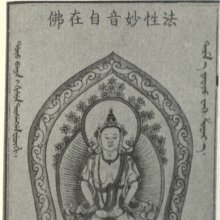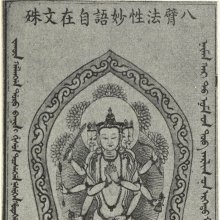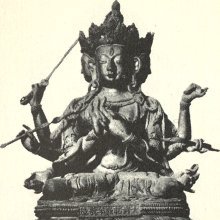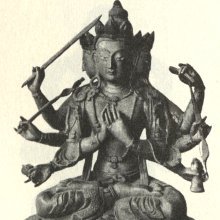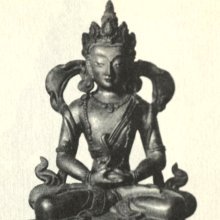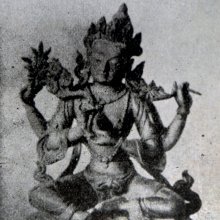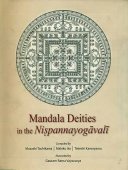Dharmadhatuvagishvara, Dharmadhātuvāgīśvara: 5 definitions
Introduction:
Dharmadhatuvagishvara means something in Buddhism, Pali, Hinduism, Sanskrit. If you want to know the exact meaning, history, etymology or English translation of this term then check out the descriptions on this page. Add your comment or reference to a book if you want to contribute to this summary article.
The Sanskrit term Dharmadhātuvāgīśvara can be transliterated into English as Dharmadhatuvagisvara or Dharmadhatuvagishvara, using the IAST transliteration scheme (?).
Images (photo gallery)
(+32 more images available)
In Buddhism
Tibetan Buddhism (Vajrayana or tantric Buddhism)
Source: archive.org: The Indian Buddhist IconographyDharmadhātuvāgīśvara (धर्मधातुवागीश्वर) refers to one of the various forms of Mañjuśrī having their Sādhana described in the 5th-century Sādhanamālā (a collection of sādhana texts that contain detailed instructions for rituals).—His colour is reddsish-white; his Āsana is the lalita; he has four faces and four arms.—Stone or bronze images of Dharmadhātuvāgīśvara are by no means common, but paintings are still made of him by the Citrakāras in Nepal.
The Dhyāna (meditation instructions) of Dharmadhātuvāgīśvara is described in the Sādhanamālā as follows:
“The worshipper should think himself as the god Dharmadhatu-Vagisvara who is eight-armed, four-faced and of reddish-white colour. His right face is red, the face behind is of lotus-red colour, and the left is of yellowish-red colour. He holds the bow and the arrow in one pair of hands, the noose and the goad in another pair, the Prajñāpāramitā manuscript and the sword in the third and the Ghaṇṭā and the Vajra in the fourth. He displays the sentiment of Śṛṅgāra (amour), and sits on the moon on a double lotus in the Lalita attitude. He is decked in celestial garments and ornaments and bears on his Jaṭaāukuṭa (crown of matted hair) the effigy of Amitābha”.

Tibetan Buddhism includes schools such as Nyingma, Kadampa, Kagyu and Gelug. Their primary canon of literature is divided in two broad categories: The Kangyur, which consists of Buddha’s words, and the Tengyur, which includes commentaries from various sources. Esotericism and tantra techniques (vajrayāna) are collected indepently.
Languages of India and abroad
Sanskrit dictionary
Source: Cologne Digital Sanskrit Dictionaries: Edgerton Buddhist Hybrid Sanskrit DictionaryDharmadhātuvāgīśvara (धर्मधातुवागीश्वर).—name of a form of Mañjuśrī: Sādhanamālā 127.20. Cf. Vāgīśvara.
Source: Cologne Digital Sanskrit Dictionaries: Monier-Williams Sanskrit-English DictionaryDharmadhātuvāgīśvara (धर्मधातुवागीश्वर):—[=dharma-dhātu-vāg-īśvara] [from dharma-dhātu > dharma > dhara] m. Name of a Buddh. deity.
[Sanskrit to German]
Dharmadhatuvagishvara in German
Sanskrit, also spelled संस्कृतम् (saṃskṛtam), is an ancient language of India commonly seen as the grandmother of the Indo-European language family (even English!). Closely allied with Prakrit and Pali, Sanskrit is more exhaustive in both grammar and terms and has the most extensive collection of literature in the world, greatly surpassing its sister-languages Greek and Latin.
See also (Relevant definitions)
Partial matches: Ishvara.
Full-text (+116): Balabhadra, Pratisamvit, Bhringi, Rahu, Ketu, Vayu, Nirkutipratisamvid, Vishnu, Calendra, Artha, Vaishravana, Mula, Arcishmati, Dharmamegha, Nairriti, Karttikeya, Svati, Shatabhisha, Dhanishtha, Purvashadha.
Relevant text
Search found 2 books and stories containing Dharmadhatuvagishvara, Dharmadhātuvāgīśvara, Dharmadhatuvagisvara, Dharmadhatuvag-ishvara, Dharmadhātuvāg-īśvara, Dharmadhatuvag-isvara; (plurals include: Dharmadhatuvagishvaras, Dharmadhātuvāgīśvaras, Dharmadhatuvagisvaras, ishvaras, īśvaras, isvaras). You can also click to the full overview containing English textual excerpts. Below are direct links for the most relevant articles:
Related products
